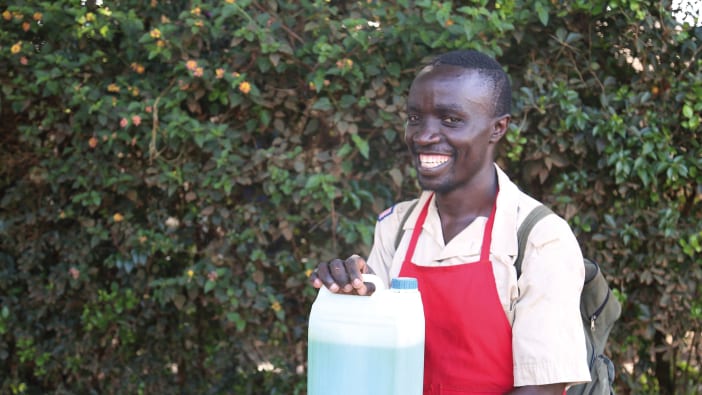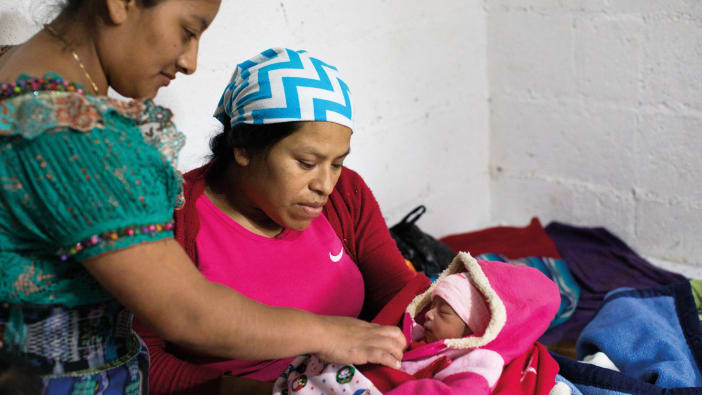by Dr Chris Curtis.
Malaria is caused by parasites (called Plasmodium) which are carried from the blood of one person to that of another by Anopheles mosquitoes (see above). This type of mosquito generally bites late at night, so bednets would be expected to be a good way of protecting against them. However, mosquitoes are very clever at finding holes or other ways into nets and they also bite arms or legs which rest against the net during the night.
A safe insecticide
These problems can be prevented by treating the bednets. The nets are soaked in a pyrethroid insecticide, so that every part of the net is saturated with a small amount of insecticide, which remains when the net dries. This treatment is called impregnation. These insecticides are safe for close contact with humans but quickly kill mosquitoes, or at least put them off feeding on blood. If most of the people in a village, boarding school or hospital are using impregnated nets, many mosquitoes are killed and it is made safer for people who get up in the night, or who do not use a net.
Impregnated nets are effective against nuisance mosquitoes (those which bite but do not necessarily carry malaria), bedbugs, headlice and some other annoying insects. This encourages people to use impregnated nets.
Choosing a net
Bednets can be made of nylon, cotton, polyethylene fibre and other materials. Clean woven plastic sacks can also be unpicked, sown together and used to make ‘fibrous curtains’. All of these can be impregnated, but if you are planning to buy nets, for people who do not already use them, strong nylon nets (made of approximately 100 denier fibre) are probably the best choice. If they are purchased in bulk from a factory, large savings can often be made, compared with the retail price in shops. Bednets are made in various sizes and you should measure the types of beds or sleeping mats used locally before ordering. Nets which are the wrong size for the bed or mat are inconvenient, so people are less likely to use them or will not be so well protected by them.
Treating the net
Impregnation is easily done. A pyrethroid insecticide is diluted to the right strength with water; each net is soaked in the mixture and wrung out, as with washing clothes. Though pyrethroids are not dangerous when diluted, they can be irritating to the skin and rubber gloves (or large plastic bags) should be worn for the soaking and wringing process. It would also be wise to wear goggles or spectacles to protect against possible splashes in the eye. After wringing out, the net is put to dry on a flat surface. If the nets are laid to dry on beds, the drips from the wet net help to reduce number of bed bugs present - a very useful side effect!
The table opposite gives the necessary details and the dilutions needed of the various chemicals. Please seek help if this table is difficult to understand or you do not know either what insecticides are available in your country, or how to obtain them.
Maintenance
Vigorous washing removes some of the pyrethroid from netting. Therefore, it was arranged with villagers in Tanzania that they should wash their nets every six months and the next day bring them to a central point in the village where the pyrethroid would be available for treatment. This arrangement worked well. In some countries, mosquitoes and cases of malaria occur mainly in the rainy season, so it is only necessary to ensure that nets are impregnated just before the rains begin and then used carefully until after the rains end.
Impressive results
In tropical and sub-tropical parts of Asia, malaria is still a major cause of ill-health despite efforts to control mosquitoes by spraying houses with insecticide. In some places, where this spraying is not successful (eg: in Hainan Island, China and among tribal people in Assam, India), large reductions in malaria have resulted from using nets impregnated with deltamethrin. In Africa, malaria is a major cause of child deaths. A recent trial in The Gambia, where primary health-care staff impregnated villagers’ own nets with permethrin, reduced the number of child deaths by 63%. The World Health Organization is planning to sponsor four large trials in different parts of Africa to see whether this remarkable result can be repeated under different conditions.
Once the nets and the pyrethroid have been obtained, this method of preventing malaria is simple to carry out and very effective.
- Could you encourage your community to discuss how to use this treatment?
- What would be the cheapest way of making or obtaining nets in your area?
Begin with the protection of young children and babies if there are not sufficient funds to protect everyone at first.
Let us know how you get on.
Dr Chris Curtis works at the London School of Hygiene and Tropical Medicine, Keppel Street, London, WC1E 7HT, UK.









